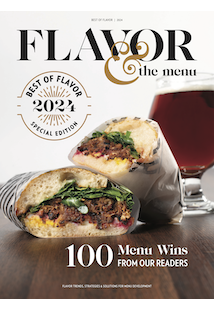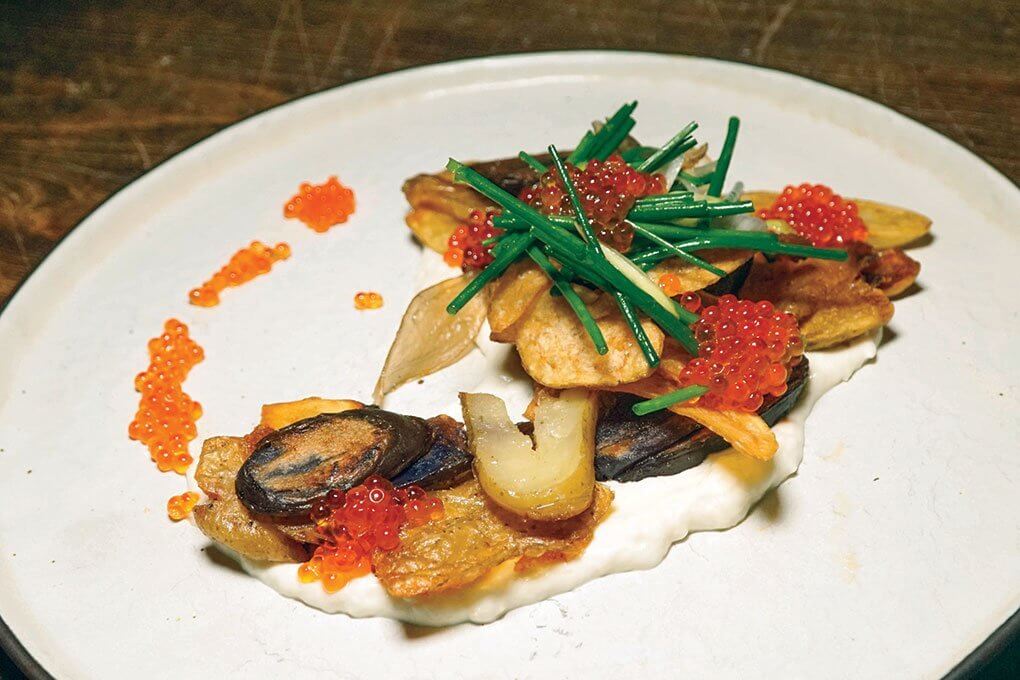As noted in Part One of our annual trends report published earlier this year, our 2018 research trips to New York, Los Angeles and Chicago involved visits to 113 carefully targeted restaurants, where we tasted 1,107 dishes in 15 working days.
One of the challenges this process presents is maintaining a “live” palate, particularly toward the end of days where we typically visit seven or eight restaurants and taste upwards of 75 dishes. After all, it’s not possible to develop those essential flavor memories if you can’t taste the food.
One tactic we use is to eschew alcohol consumption, which, despite its ability to whet the appetite, ultimately results in loss of focus. Instead, sparkling water is the beverage of choice, which is both refreshing and palate-cleansing.
Still, I would be dishonest if I claimed to not occasionally experience palate burnout during these marathon trips. But on occasion, in the waning hours of a research day, we will sample a dish whose flavors are so compelling, it stands us up in our seats and snaps our taste buds back to attention.
One such dish was the Overpriced Tomato, served by Joe Frillman, executive chef and owner at Daisies in Chicago: a sliced, perfectly ripe heirloom tomato served on toasted sourdough topped with torn basil and sprinkles of balsamic vinegar and fleur de sel. It is the most delicious tomato I have ever tasted, without exception. The reason is that just before garnishing, Frillman brushes the tomato slices with melted bone marrow, which serves to intensify the fresh tomato flavor exponentially. Such dishes are the reward we receive for our research efforts.
The following are several of the best examples of ingredients and techniques that chefs are employing in the nation’s newest restaurants to further expand the frontiers of flavor.

At Daisies in Chicago, the Overpriced Tomato stood out as one of the most flavorful dishes on the tour, thanks to melted bone marrow, basil, balsamic vinegar and fleur de sel.
Caviar: American Gems
In their never-ending quest for greater levels of craveability, chefs nationwide are increasingly turning to caviar and assorted fish roe as go-to flavor-boosting garnishes. Tiny dollops of shimmering black, green, gray, golden and crimson eggs are adding style and umami to open-faced sandwiches and tartines, salads, seafood plates, pastas, dips and spreads, veg-centric dishes and single-bite snacks.
Coinciding with this movement is a growing acceptance of the premium-quality caviars that are being produced here in the United States. Harvested and packed using the same careful practices as imported caviar, the flavors and textures of these domestic varieties rival all but the rarest products of the Caspian Sea, but at a fraction of the cost.
Excellent caviars from the American White and American Siberian species of sturgeon are produced in sustainable aquaculture farms in California, Idaho and Florida, yielding dark gray to brown/black pearls with an appearance and flavor similar to imported osetra.
Clever and creative menu finds from the Trends Tour
Lesser known but equally delicious are caviars harvested from wild-caught river sturgeon in the American South such as the hackleback and spoonbill, which produce small to medium-sized silvery gray pearls offering rich and robust flavors.
American caviars from non-sturgeon fish species are being produced in unexpected locales, including golden whitefish caviar from Michigan and rainbow trout roe from the state of Washington, which is seeing a lot of action on menus as chefs appreciate the smaller-sized pearl and sweeter, milder flavor compared to that of the more common salmon roe.
Guy Meikle, executive chef and president at Heritage Restaurant & Caviar Bar in Chicago, is an enthusiastic proponent of American caviars, which are a highlight of his menu. A rotating choice of a half-dozen varieties is available, served with a casually elegant platter of garnishes, including sieved egg yolk, crème fraîche, diced red onion, chives, housemade potato chips, pickles and black bread.

Clockwise from top left: Smoked Trout Pâté with black bread at The Cannibal Liquor House in New York; Mushroom on Waffle with cauliflower soubise, brown-butter ponzu and caviar at Chumley’s in New York; Chicago’s City Mouse serves a charming Country Mouse—a cheddar, caramel and caviar shooter; A decadent combination at Heritage Restaurant & Caviar Bar in Chicago: Eggs on Eggs combines two kinds of roe atop soft scrambled eggs with crabmeat.
The caviars are also incorporated into dishes across the menu, including Meikle’s signature breakfast/brunch dish of Eggs on Eggs, a celebration of umami featuring lump crabmeat, kimchi with soft scrambled eggs, bone marrow and crème fraîche, garnished with dollops of both rainbow trout roe and wild Louisiana bowfin roe.
Generous spoonfuls of trout roe adorn a sharing plate of Shaved Fingerlings at Beatnik in Chicago, where Marcos Campos, executive chef, layers slices of fried fingerling potatoes with leek labneh, chive and roasted shallot salad. The menu at New York speakeasy Chumley’s features a savory Mushroom Waffle topped with cauliflower soubise, brown butter ponzu and American white sturgeon caviar.
At Daisies in Chicago, Frillman tops his dish of housemade Beet Agnolotti with sour cream, dill sprigs and lightly smoked trout roe. The Smoked Trout Pâté and Black Bread served at The Cannibal Liquor House in New York also receives a garnish of smoked trout roe.
The Country Mouse is a caviar-topped single-bite snack at City Mouse in Chicago, from chef/partner Jason Vincent, that has become a favorite of dining guests and Instagrammers alike: a small cube of breaded and fried cheddar cheese adorned with a thin slice of caramelized sugar and Mississippi sturgeon caviar—an odd-sounding ingredient combination whose flavors meld perfectly.
Claire Welle, chef/partner at the acclaimed Otway in Brooklyn, N.Y., serves a diminutive Caviar Tart filled with a smoked bluefish mousse that is hidden beneath a layer of trout roe. It, too, is meant to be consumed in one highly pleasurable bite.
These domestic caviars are enabling chefs to create visually arresting plate presentations featuring a unique combination of craveability and affordable elegance.
Veg-Centric Evolves
There are few reports on foodservice trends today that do not call out plant-focused dining as a top opportunity—and with good reason. For the past several years, the menus of newly opened restaurants in the largest U.S. cities have shown both a marked increase in the number of dishes where vegetables or fruits constitute the center of the plate, and a shift away from the menu category of “sides,” where vegetables have typically been relegated, in favor of a dedicated offering of highly creative dishes under the heading of “vegetables.”
Omnivorous dining consumers are the primary target, as many of the dishes are not meatless, but rather enhanced with small meat or seafood protein additions, resulting in levels of craveability that could not be achieved by plying vegetable proteins alone.
Starting with kale and then progressing to Brussels sprouts and cauliflower, each year a few more vegetables (and fruits) emerge as menu stars, simultaneously capturing the imaginations of chefs across the country. Two in particular stand out from this year’s research: sweet potatoes and heirloom tomatoes.
Roasted whole and topped with a wide variety of sweet and savory accompaniments, sweet potatoes have gained significant traction on menus. Chefs are choosing extra-large sweet potatoes for these dishes, both enhancing the value equation and making them ideal for sharing.

(Clockwise from top left): Heirloom tomatoes take a leading role on menus – at Split-Rail in Chicago, tomato wedges rest upon feta cheese mousse and sourdough toast; Loaded Sweet Potato Benedict with black beans, avocado salsa verde and poached eggs at Portsmith in Chicago; The Exchange in Los Angeles offers Grilled Sweet Potato with roasted almond and chile morita; Ella Elli in Chicago combines heirloom tomatoes with cucumber, aged feta and basil.
New York’s Motel Morris offers a Roasted Sweet Potato as a sharing plate, topping the split potato with labneh that has been whipped with maple syrup, and finished with a drizzle of olive oil and a sprinkle of fleur de sel.
On the breakfast menu at Portsmith in Chicago, Nate Henssler, executive chef/partner, serves his signature Loaded Sweet Potato Benedict, which layers black beans and a creamy avocado salsa verde atop poached eggs, attractively garnished with fines herbes and shavings of red jalapeño peppers and breakfast radishes.
The Salt Baked Sweet Potato at Mexican restaurant Tallula’s in Santa Monica, Calif., is a multi-layered dish of pork carnitas, black beans and hominy, slathered with a charred chile salsa and finished with a generous topping of melted Monterey Jack.
At The Exchange in Los Angeles, the Grilled Sweet Potato is first oven roasted and then split and grilled over a wood fire, then topped with an olive oil-based condiment of roasted and chopped almonds and ground morita chiles.
Sarah Hymanson and Sara Kramer, chefs and partners at the highly acclaimed Los Angeles restaurant Kismet, serve a Sweet Potato that features a clever mash-up of Middle Eastern and Southern California ingredients, topping the roasted and peeled potato with puffed wild rice, mustard frills and a coconut vinaigrette.
As a center-of-the-plate ingredient, sweet potatoes have much to recommend them. They are economical, simple to prepare, and hold well after baking or roasting. They also provide chefs with a reliable product that may be offered throughout the year.
More than any other ingredient, heirloom tomatoes rose to prominence on menus in all three research cities, featured in an almost endless variety of salads, sharing plates and handhelds.
Grown in a wide variety of shapes and sizes, heirloom tomatoes offer sweet flavor profiles with dense, meaty and moist flesh. They also enable chefs to easily create plates with dramatic eye appeal, as the tomatoes are available in a rainbow of color combinations that includes shades of red, yellow, orange, green and purple.
The sharing plate of Heirloom Tomatoes at Chicago’s Publican Anker is a sophisticated composition of avocado, bacon, arugula, pea shoots and crispy shallots tossed with oblique chunks of tomato in a simple oil-and-vinegar dressing.
Similarly, the Heirloom Tomatoes dish at ABCV in New York combines fresh figs, Persian cucumber, pickled red onion and torn herbs in a shiso-ginger dressing.
Catch up on the first part of the 2018 Trends Tour
Multiple varieties of tomato including beefsteak, plum and cherry distinguish the Heirloom Tomato Salad at Ella Elli in Chicago, garnished with shaved curls of cucumber and baby basil leaves, and finished with a blizzard of powdered aged feta.
While not a particularly attractive presentation, the LT sandwich at Daily Provisions in New York achieves flavor perfection via an ingredient triad of a single, extra-thick slice of heirloom tomato topped with watercress and a lemon-basil aïoli.
Conversely, the Heirloom Tomato Toast at Split-Rail in Chicago by Zoe Schor, chef/owner, is a portrait-worthy assemblage of sourdough toast spread with feta cheese mousse, topped with tomato wedges, toasted seeds and soft herbs drizzled with a jalapeño vinaigrette.
What’s noteworthy is that these delicious tomato dishes are increasingly extended into fall and winter, when the product could certainly not be coming from the local farmers’ market. The reason, of course, is that these heirloom tomatoes are in large part being grown hydroponically. Chefs seem to be embracing this expanded availability, which we view as a welcome departure from the hyper-seasonal mindset that has prevailed over the past decade, resulting in a nearly complete absence of tomatoes on menus in the months of November and December
Octopus: Armed & Ready
When we first cited octopus as a menu opportunity in these pages in 2013, it was still seen as a bit of a fringe ingredient, and in subsequent years the growth of menu incidences was not particularly rapid. Our most recent research shows a major increase in the number of octopus dishes on offer, signaling a move toward the mainstream.
Today, the majority of chefs are prepping the octopus by simmering it in a flavored water or broth until tender, and finishing it at service on a char grill, resulting in a tender bite and a smoky, crunchy exterior.
At The Albert in Chicago, Larry Feldmeier, executive chef, serves char-grilled Spanish Octopus in a pool of a spicy harissa-based sauce with charred shishito peppers and a sprinkle of toasted and chopped pistachios.
Harissa also adds a piquant kick to the Grilled Baby Octopus at nearby Chicago restaurant Eden, which Devon Quinn, chef/partner, presents on a bed of forbidden rice with fresh artichokes, arugula, raw corn and new potatoes, finishing the dish with tiny spoonfuls of the chile paste.
Another winning flavor strategy is to pair the octopus with boldly flavored cured meats or sausage. Both Sweet Chick in Los Angeles and Camperdown Elm in Brooklyn, N.Y., serve octopus with a cured meat accompanied by smoked potatoes—the former featuring Grilled Octopus with shavings of Tennessee country ham, smoked fingerlings and a creamy burnt-orange sauce, and the latter serving Octopus with morcilla, the classic Spanish cured blood sausage, cut into a fine dice and garnished with tomatillo purée and smoked baby creamer potatoes.
Creamy bean purées also emerged as a frequent accompaniment. Motel Morris features a Sweet Chili Charred Octopus served in a pool of white bean purée with fingerling potatoes, scallions and preserved lemon.
The Grilled Baby Octopus at The Mar Vista in Los Angeles is a highly impressive presentation of a half octopus with its long, curly tentacles intertwined, sitting atop a cannellini bean-and-bacon purée with an heirloom cherry-tomato pesto.
The lunch menu at Tortoise Supper Club in Chicago features a Grilled Octopus Pita garnished with a generous slathering of creamy smoked hummus with harissa, illustrating the opportunity to incorporate octopus into unique and creative handhelds.
Ample opportunities exist to create menu differentiation with this tasty sea creature. Dining consumers value restaurant foods they cannot easily prepare at home, and octopus most certainly falls into that category. It also carries a certain amount of cachet as an exotic menu item, providing appeal to more adventurous Millennial diners.

Octopus presents bold new flavors (clockwise from top left): Sweet Chili Charred Octopus at New York’s Motel Morris; Spanish Octopus at The Albert in Chicago; The Mar Vista in Los Angeles showcases octopus with cannellini bean-bacon purée and cherry-tomato pesto; Chicago’s Eden serves New Baby Octopus with potato, harissa, corn and artichoke.











